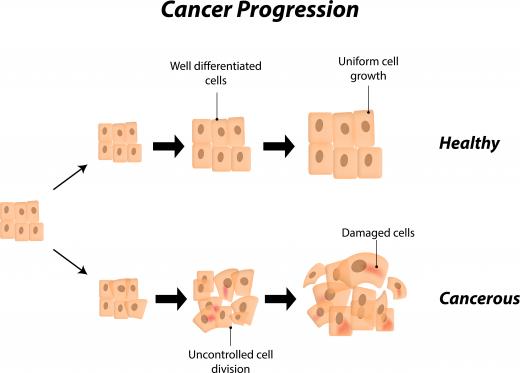What is an Extracellular Matrix?
 Mary McMahon
Mary McMahon
An extracellular matrix is a network of non-living tissue that provides support to cells. It also performs a number of other very specific functions, depending on the types of cells it is associated with, and it takes many forms. The constituent materials in this structure can vary widely; plants, for example, build them from cellulose, while animals produce extracellular matrices with proteins, minerals, and certain carbohydrates.
The term “extracellular” literally means “outside the cell,” which explains where the matrix is located. In some cases, it is actually secreted by the surrounding cells. In bone, for example, a mineralized extracellular matrix is designed to provide support and resist compression. In some cases, the matrixsimply fills up the space between different types of tissue, ensuring that they are kept separate and that their functions are not disturbed.

The skin has an extensive extracellular matrix that keeps it elastic and strong. The skin's matrix also plays an important role in the healing process, as do such structures elsewhere in the body. It can also help to regulate communication between cells and the production of certain substances in the body. In addition, it provides a framework for cell adhesion, encouraging growth and stable healing.
Bones, muscles, and tendons all have extensive extracellular matrices that allow them to perform a variety of functions in the body. Tendons and ligaments have special proteins that allow them to be stretched and contracted so that the body can be moved, while bone is made primarily from collagen and mineral deposits, creating a very solid, secure structure.
Depending on the type of extracellular matrix is involved, specific cells may be required to build it. Fibroblasts, for example, secrete the matrix that creates fibrous connective tissue, while osteoblasts make new bone. When these cells are disrupted in some way, it can cause serious problems, as the body constantly reabsorbs the substances it makes even as it produces more; if no more is being produced, or the matrix is being overproduced, it can cause health conditions.
When cancers attack the body, one of the things they assault first is the extracellular matrix in the region where they grow. Cancers secrete certain enzymes that digest the structure, providing a direct link with the tissue beneath it and allowing the cancer to metastasize as it breaks up and distributes cells to new regions. Without these enzymes, the cancer would not be able to penetrate the vulnerable tissue of the body.
AS FEATURED ON:
AS FEATURED ON:











Discussion Comments
@cloudel - Collagen is part of the extracellular matrix that just cannot be replaced by putting on a topical cream. You have to stimulate production of it from the inside.
There are creams out there that claim to be able to do this. Just don’t buy any cream that actually contains collagen, because it will be useless for this.
Of course, protecting your skin from the sun and avoiding stress will help prevent you from losing pieces of your extracellular matrix to begin with. However, if you need to produce more collagen, I’ve heard that vitamin C helps boost production of it.
My dermatologist also told me about certain products that are good for stimulating production, so you might want to ask yours for professional advice before investing a lot of money into an anti-aging product.
The elastin and collagen in skin are part of the extracellular matrix. I learned this while researching various anti-aging creams.
I didn’t know that they were outside the cell until I read an article about their functions. It makes sense, though, because they offer support and elasticity. Support is usually something that you find along the outer walls of vulnerable things.
Well, I learned about the biology of elastin and collagen, but I’m still not sure which beauty product to buy. There are some that say they actually contain collagen, but there are others that don’t make this claim. I’m unsure of which would be the better choice.
I did know that cancer attacks cells, but I didn’t know that actually attacked the extracellular matrices. That is pretty rough and quite sneaky.
So, it sounds like cancer knows what it’s doing. It’s pretty crazy how the inner workings of the human body are so advanced. It’s creepy that diseases know how to take us apart by starting with our protective coatings.
Cancer is like an army of invaders who rip up a city and move in to call it home. I suppose the houses of the people would be the extracellular matrices, in this case.
Post your comments